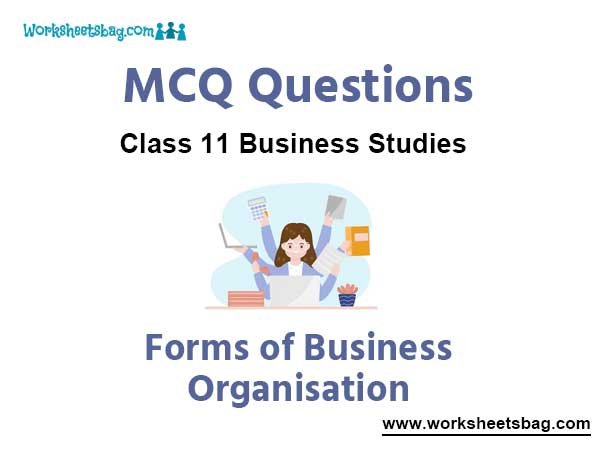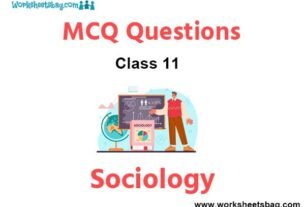Please refer to Forms of Business Organisation MCQ Questions Class 11 Business Studies below. These MCQ questions for Class 11 Business Studies with answers have been designed as per the latest NCERT, CBSE books, and syllabus issued for the current academic year. These objective questions for Forms of Business Organisation will help you to prepare for the exams and get more marks.
Forms of Business Organisation MCQ Questions Class 11 Business Studies
Please see solved MCQ Questions for Forms of Business Organisation in Class 11 Business Studies. All questions and answers have been prepared by expert faculty of standard 11 based on the latest examination guidelines.
MCQ Questions Class 11 Business Studies Forms of Business Organisation
Question. _______ company needs to have only two directors.
(a) Public Company
(b) Sole Proprietorship
(c) Private Company
(d) None of the above
Answer
C
Question. Which one of the following is the CORRECT sequence of stages in the formation of a company?
(a) Promotion, incorporation, capital subscription, the commencement of business
(b) Incorporation, capital subscription, promotion, the commencement of business
(c) Promotion, the commencement of business, incorporation, capital subscription
(d) Promotion, Incorporation, Certificate of commencement, capital subscription
Answer
A
Question. __________ company does not invite the public to subscribe to its share capital.
(a) Both Private and Public Company
(b) Public Company
(c) Private Company
(d) None of the above
Answer
C
Question. Which of the following cooperative society is established to help small producers in selling their products?
(a) Producer cooperative society
(b) Marketing cooperative society
(c) Credit cooperative society
(d) Consumers cooperative society
Answer
A
Question. The maximum number of partners allowed in the banking business are
(a) Ten
(b) No limit
(c) Twenty
(d) Two
Answer
A
Question. It is a form of business organization which is owned, managed, and controlled by an individual who is the recipient of all profits and bearer of all risks. Identify the concept.
(a) Sole Proprietorship
(b) Cooperative Society
(c) Joint Hindu family business
(d) Partnership
Answer
A
Question. Which of the following forms of business enterprises suffer from a lack of public confidence because they are not required to publish their accounts legally?
(a) Partnership
(b) Cooperative Society
(c) Company
(d) None of the above
Answer
A
Question. Every partner is both an agent and a principal. Identify the characteristic of the partnership being referred here.
(a) Mutual Agency
(b) Risk Bearing
(c) Membership
(d) Formation
Answer
A
Question. The life of sole proprietorship business is ___________
(a) Very short life
(b) Stable
(c) Long life
(d) Unstable
Answer
D
Question. The form of business organization that has the largest sales volume is the:
(a) Partnership
(b) Corporation
(c) Cooperative
(d) Multinational
Answer
B
Question. Profits do not have to be shared. This statement refers to :
(a) Partnership
(b) Joint Hindu Family business
(c) Sole proprietorship
(d) Company
Answer
C
Question. A partnership firm can be registered under:
(a) The Partnership Act, 1932
(b) The Indian Contract Act, 1872
(c) The Partnership Act, 1994
(d) The Partnership Act,1922
Answer
A
Question. The structure in which there is separation of ownership and management is called
(a) Sole proprietorship
(b) Partnership
(c) Company
(d) All business organizations
Answer
C
Question. The simplest form of business ownership is a:
(a) proprietorship.
(b) partnership.
(c) corporation.
(d) cooperative.
Answer
A
Question. In a cooperative society the principle followed is
(a) One share one vote
(b) One man one vote
(c) No vote
(d) Multiple votes
Answer
B
Question. The maximum number of partners allowed in the banking business are
(a) Twenty
(b) Ten
(c) No limit
(d) Two
Answer
B
Question. Sense of accomplishment is present in which of business organisation:
(a) Partnership
(b) Company
(c) Joint Hindu Family business
(d) Sole proprietorship
Answer
D
Question. The structure in which there is separation of ownership and management as per law is called
(a) Company
(b) All business organisations
(c) Partnership
(d) Sole proprietorship
Answer
A
Question. The capital of a company is divided into number of parts each one of which are called:
(a) Dividend
(b) Profit
(c) Interest
(d) Share
Answer
D
Question. Which one of the following may not be a factor behind starting a business?
(a) Routine workload
(b) size of the firm
(c) finance
(d) location of the business
Answer
A
Question. A private company is one which:
(a) Limits the number of members
(b) Restricts the transferability of shares
(c) Prohibits the public to subscribe to its securities
(d) All of these
Answer
D
Question. On the basis of duration partnership are classified into:
(a) Partnership at will and particular partnership
(b) General partnership and limited partnership
(c) Long partnership and short partnership
(d) None of these
Answer
A
Question. The karta in Joint Hindu family business has
(a) Limited liability
(b) Unlimited liability
(c) No liability for debts
(d) Joint liability
Answer
B
Question. The structure in which there is separation of ownership and management is called
(a) Sole proprietorship
(b) Partnership
(c) Company
(d) All business organisations
Answer
C
Question. The board of directors of a joint stock company is elected by
(a) General public
(b) Government bodies
(c) Shareholders
(d) Employees
Answer
C
Question. A partner who is not actually involved in the partnership but lends his name for public relations purposes is a:
(a) silent partner.
(b) general partner.
(c) nominal partner.
(d) dominant partner.
Answer
C
Question. Which of the following is probably the most important reason for incorporating?
(a) limited liability of shareholders.
(b) more money for investment.
(c) increased flexibility.
(d) shared management.
Answer
A
Question. Transfer of interest exists in the case of
(a) Profession
(b) employment
(c) business
(d) none of these
Answer
C
Question. Which of the following forms of business organisation has limited liability to his members:
(a) Partnership
(b) Company
(c) Sole proprietorship
(d) Joint Hindu Family business
Answer
B
Question. The Head of the Joint Hindu Family business is called :
(a) Proprietor
(b) Director
(c) Karta
(d) Manager
Answer
C
Question. __________ company does not invite public to subscribe to its share capital
(a) Both Private and Public Company
(b) Public Company
(c) Private Company
(d) None of the above
Answer
C
Question. It is a form of business organization which is owned, managed and controlled by an individual who is the recipient of all profits and bearer of all risks. Identify the concept.
(a) Sole Proprietorship
(b) Cooperative Society
(c) Joint Hindu family business
(d) Partnership
Answer
A
Question. A company named Tech pvt ltd wants to issue its shares to the general public. Can the company do so:
(a) Yes
(b) Yes, after taking permission from the government
(c) Yes but there will be a few restrictions
(d) No
Answer
D
Question. Which of the following is an advantage of a sole proprietorship ?
(a) ease of starting a business.
(b) being your own boss.
(c) pride of ownership.
(d) all of the above.
Answer
D
Question. In case of running a Joint Hindu Family business there must be at least _____ members in a family.
(a) 6
(b) 4
(c) 2
(d) 8
Answer
C
Question. Which of the following is an example of a non profit organization?
(a) Royal Bank.
(b) YMCA.
(c) BCE.
(d) Air Canada.
Answer
B
Question. All members who have equal ownership rights over the property of an ancestor are known as __________:
(a) Family members
(b) Coparceners
(c) Business Partners
(d) Heirs of the Business
Answer
B
Question. A company being an artificial person can:
(a) Enter into contracts
(b) Can sue the third party or its members
(c) Can be sued by its members or any other third party
(d) All of these
Answer
D
Question. Which of the following business organisation has service motive?
(a) Sole Proprietorship
(b) Joint Hindu Family
(c) Cooperative Society
(d) Company
Answer
C
Question. In a cooperative society, the power to take decisions lies in the hands of.
(a) Elected Managing Committee
(b) Karta
(c) Board of directors
(d) Members
Answer
A
Question. The form partnership which was restricted in India is.
(a) Particular Partnership
(b) General Partnership
(c) Partnership at will
(d) Limited Partnership
Answer
D
Question. Maximum number of members in Private company are
(a) 50
(b) 100
(c) 150
(d) 200
Answer
D
Question. Minimum numbers of Board of Directors in any Private company can be
(a) 3
(b) 2
(c) 4
(d) 5
Answer
B
Question. A partner whose association with the firm is unknown to the general public is called
(a) Active partner
(b) Sleeping partner
(c) Nominal partner
(d) Secret partner
Answer
D
Fill in the Blanks:
Question. Hindu Undivided Family Business is governed by __________ act 1956.
Answer
Hindu succession
Question. Forms of Business which is suitable for small business is ___________ .
Answer
Sole Proprietorship
Question. The maximum number of shareholders in any Private company is _________
Answer
200
Question.The head of the family, in Hindu Undivided family is called __________ .
Answer
Karta
Question. There is __________ restriction on transfer of share.
Answer
No
True/False Answer Questions
Question. If a company suffers heavy issues and its assets are not enough to payoff its liabilities, the balance can be recovered from the private assets of its members.
Answer
False
Question. A company can ratify preliminary contracts after incorporation.
Answer
True
Question. Every company must file Articles of Association.
Answer
False
Question. In a joint stock professional management is not possible .
Answer
False
Question. Appointment of underwriters is necessary in the capital subscription stage.
Answer
False
Question. Members of any Private Ltd. Company cannot transfer his shares without permission of shareholders.
Answer
True
Question. The cooperative society can be started with a minimum of two members.
Answer
False
Question. Sole proprietors have limited liability.
Answer
False
Question. If a company is registered on the basis of fictitious names, its incorporation is invalid.
Answer
False
Question. Statement in lieu of prospectus can be filed by a public company going for a public issue.
Answer
False
Match the following:
Question. Match the following forms of business organisation on the basis of control and management.
| (a) Company | 1. Owner takes all decisions, quick decision making |
| (b) Cooperative society | 2. Separation between ownership & Management |
| (c) Joint Hindu family | 3. Elected Representative managing committee takes decisions |
| (d) Sole Proprietorship | 4. Karta takes decisions |
Answer
(a) – 2, (b) – 3, (c) – 4, (d) – 1
Question. Match the Column on the basis of features of Hindu Undivided Family-
| (a) continuity | 1. Karta takes all the decisions |
| (b) Control | 2. Does not require any agreement |
| 3. Remain even after the death of Karta. |
Answer
(a) – 3, (b) – 1
Question. Match the Acts with their years-
| (a) Hindu Succession Act | 1. Act 1932 |
| (b) Partnership | 2. Act 1912 |
| 3. Act1956 |
Answer
(a) – 3, (b) – 1
Question. Match the minimum number of member require in the form of business organization-
| (a) HUF | 1. 10 members |
| (b) Cooperative | 2. 2 members |
| 3. 5 members |
Answer
(a) – 2, (b) – 1
One word Answer type Questions :
Question. What is the basis of membership in the Joint Hindu Family Business?
Answer. Birth in a particular family.
Question. Which is the least regulated form of business?
Answer. Sole proprietorship.
Question. Whose decisions are binding on all the members of the Joint Hindu Family Business?
Answer. Karta.
Question. What happens to Joint Hindu Family Business if Karta or any other member dies?
Answer. Business continues.
Question. In which form of organisation is a trade agreement made by one owner binding on the others?
Answer. Partnership.
Question. Mr. Gurpreet wants to apply for the shares of ACC Ltd. From which document he will get the details.
Answer. Prospectus.
Question. List the minimum number of directors required in case of private and public company.
Answer. (a) Private company-2. (b) Public company-3.
Question. “Employees Union of Bharat Textiles start a retail store to make daily household articles at reasonable prices available to its members.” Name this form of business organisation.
Answer. Cooperative society (Consumers’ cooperative society).
Question. Name the basic document prepared in partnership firm.
Answer. Partnership deed.
Question. Define partnership deed.
Answer. The document containing the terms and conditions of the partnership agreement is called partnership deed.
Question. A company get registered with an illegal object. Can the registration be questioned?
Answer. No, the registration cannot be questioned if the registrar has already issued the Certificate of Registration.
Question. Which type of company cannot invite public to subscribe to its share capital?
Answer. Private company.
Question. Name the enterprise involving single ownership.
Answer. Sole proprietorship.
Question. Name the type of partner who contributes capital and also takes active participation in the management of the firm.
Answer. Active partner.
Question. Name the form of business organisation which can be formed by an oral agreement between the members.
Answer. Partnership.
Question. Which business organisation is least advantageous on the basis of availability of capital?
Answer. Sole proprietorship.



